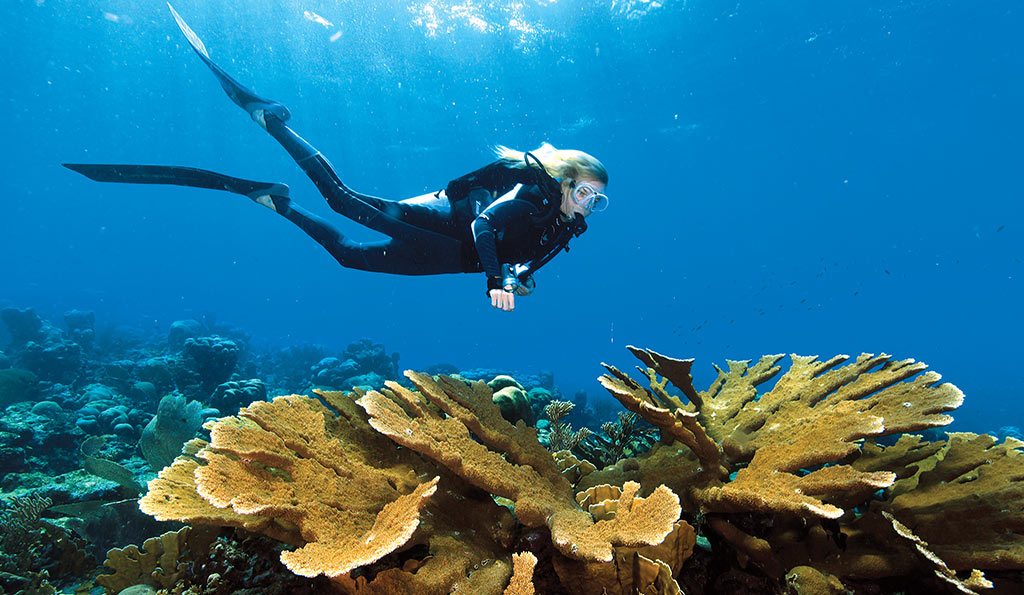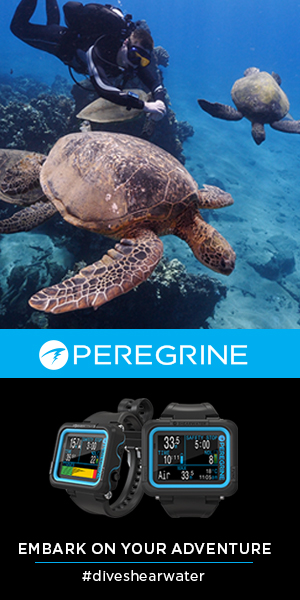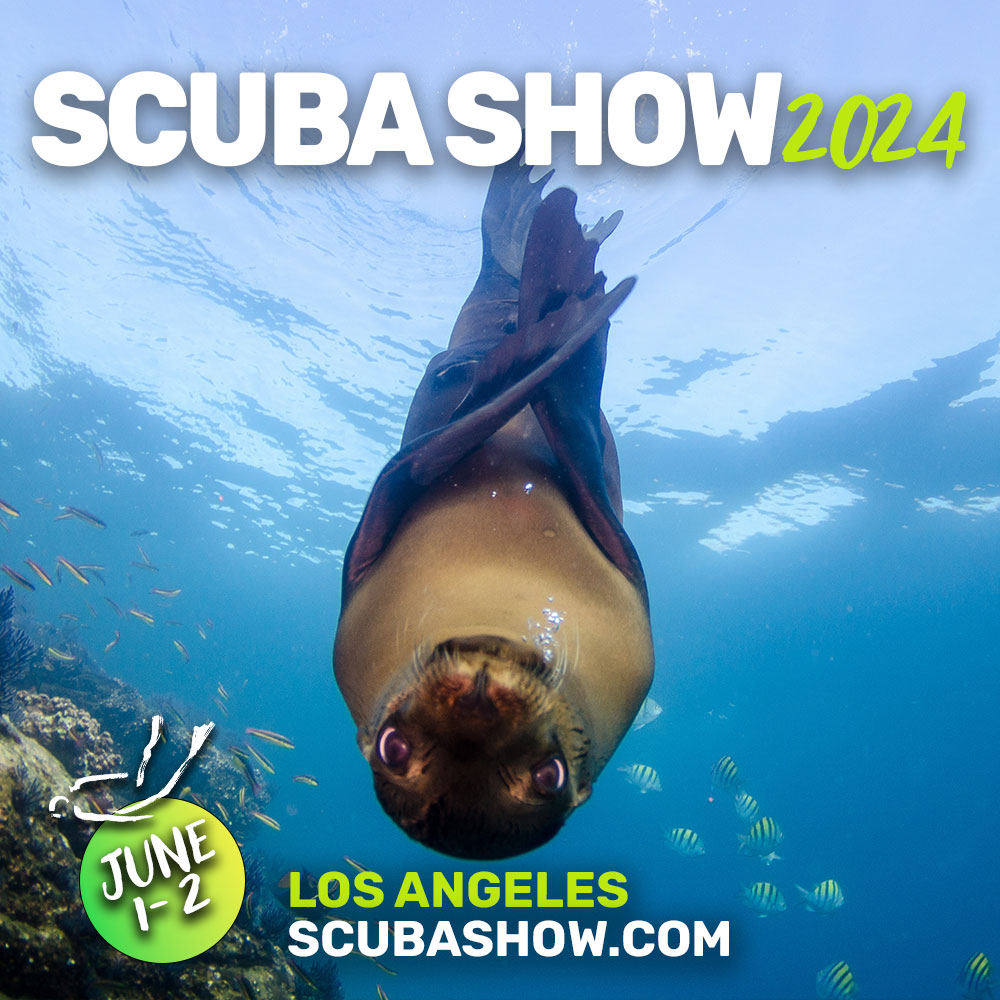There are a great many things about the island of Curaçao that are hard to describe until you visit in person. Take, for instance, the color blue. As we looked out from the “banda ‘abou” or “downwind” shore along the west coast we saw blues of all hues — aqua, turquoise, royal, cerulean — and more. Curaçao is famous for its blue, from the various colors of its crystal-clear waters to the popular liqueur called Blue Curaçao, which is produced from a locally grown — and decidedly orange-colored — citrus fruit called the laraha. Whether you’re looking through the lens of a scuba mask during a dive or into a cocktail glass while admiring the tropical sunset, Curaçao’s got the perfect shade of blue. The island also has a particular warmth and friendliness about it. You’ll hear the expression, “bon bini,” spoken often. It means, “welcome” and is always said with a smile.
The Island of the Giants
Curaçao (pronounced cure-a-sow) is in the Caribbean Sea, yet it lies on the continental shelf of South America, only 35 miles (56 km) north of Venezuela, about 70 miles (112 km) east of Aruba, and 50 miles (80 km) west of Bonaire. It features a tropical savannah climate different from what one might expect from a Caribbean island or the South American tropics. Its vegetation is more scrub and cactus than lush green. Curaçao is volcanic in origin, but lacking the mountainous peaks one might imagine. The countryside, or “cunucu,” is mostly flat until you head north, where Mount Hyronimus reaches 759 feet (230 m) and Mount Christoffel rises to 1,238 feet (375 m).
Discovered in 1499 by a lieutenant of Christopher Columbus, Spanish explorer Alonso de Ojeda, Curaçao was originally christened, “Isla de los Gigantes” (land of the giants). This is presumably a reference to the large stature of the original inhabitants, the Arawaks. There are several theories as to how Curaçao got its current name, mostly likely from the Portuguese word “coração,” meaning “heart.” This seems fitting, as Curaçao’s “pet” name is “Dushi Korsou,” which means, Sweet Curaçao.
It wasn’t until about 1527 that the Spanish settled on Curaçao. By the early 1600s the enterprising Dutch fancied the island for its naturally protected deepwater port, eventually taking control in 1634. Under Dutch rule, Curaçao was developed into a thriving port bustling with international commerce. In homage to their motherland, early architects patterned the buildings after those found in Amsterdam, with exquisite 17th- and 18th-century Dutch colonial buildings not found anywhere else outside the Netherlands. In time, as Willemstad’s traditional styles were modified to accommodate the island’s dry and breezy climate, Caribbean accents, such as verandas, porches, fretwork and shutters — and a bright color palette — were added.
Not all of Curaçao’s history is pretty. In 1662, Willemstad, under the direction of the Dutch West India Company, became a major player in the slave trade. The Kura Hulanda Museum does a remarkable job of recognizing this dark period of mankind’s history. The Dutch abolished slavery in 1863.
Despite profiting from early slave trading, Curaçao has long been a haven for those seeking freedom from political and religious persecution. Williamsted’s Mikve Israel-Emanuel Synagogue, established in 1674, is the oldest in the Western Hemisphere.
Curaçao went back and forth between British and Dutch control several times from the end of the 17th century to the early 19th century, with the Dutch finally establishing sovereignty in 1815. The island has remained under Dutch rule ever since.
During the early 1900s the discovery of Venezuela’s rich oil resources meant a big boon to Curaçao’s economy. The Royal Dutch Shell Company established one of the world’s largest oil refineries, which ushered in a period of financial prosperity from which the island continues to benefit.
From the mid-1800s until 2010, Curaçao, the uninhabited island of Klein Curaçao and the other islands of the former Netherlands Antilles were “island territories.” On October 10, 2010, the Netherlands Antilles dissolved and Curaçao became a “constituent country of the Kingdom of the Netherlands” and is formally called the Country of Curaçao.
The island currently has a population of about 150,000 people representing a variety of ethnic backgrounds. Dutch and Papiamentu are the official languages, and English is widely spoken. Tourism is now the leading industry.
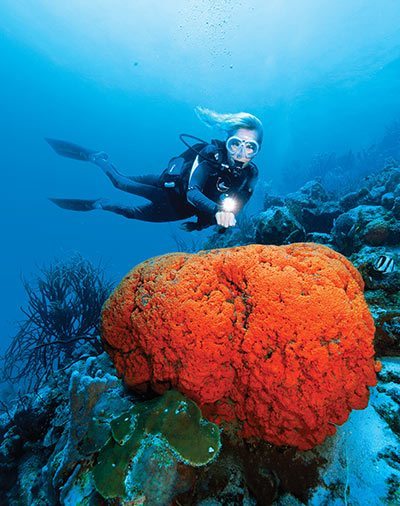
Colorful sponges of gigantic proportion are commonly seen on Curaçao’s reefs.
‘Dushi’ Diving
The great news for divers visiting Curaçao? In a word, the diving is “sweet.” Conditions are suitable for those with all levels of training, from new diver to experienced veteran. Curaçao is wisely protecting its rich marine resources, with three areas of national park (Banda Abou, Central Curaçao and Curaçao Underwater Park) and a total surface area exceeding 1,482 acres (593 hectares) of reef and more than 1,077 acres (431 hectares) of inner bays. The Caribbean Research & Management of Biodiversity (CARMABI.org) has a variety of research and education programs, both topside and underwater, geared toward protecting the island’s natural bounty.
Many of Curaçao’s fringing reefs can be accessed from shore. Several dive resorts have nearby reefs that offer easy entries. You can also rent a car and drive to a variety of good diving and snorkeling sites, many of which are marked by “diver down” flags painted on rocks. Ask the staff at the dive center for their recommendations. The best shore diving is on the south (leeward) side; northern coast conditions are not generally suitable for shore entries. Limestone composition and the arid climate means little runoff, which translates into excellent underwater visibility, ranging from 50 to 150 feet (15 to 45 m) on average.
Diving on your own from shore is OK, but to be honest, the best sites are within a short boat ride from shore, and there’s nothing like taking advantage of guided dives to really get the most out of your adventure. Curaçao offers more than 40 dive sites marked with mooring buoys. Dive operators typically offer a two-tank morning boat dive, followed by a one-tank afternoon trip. Average depths at most dive sites range from 40 to 80 feet (12 to 24 m) with walls that drop off to below sport diving depths. Water temperatures range in the low- to mid-80s Fahrenheit (mid- to high-20s Celsius). A 3-millimeter full suit or layered tropical exposure protection is sufficient.
At the start of our first dive we were thrilled to see abundant and healthy stands of staghorn and elkhorn coral growth along the fringing reef, and healthy numbers of sea fan corals waving back and forth in the shallows. We were perfectly happy right below the boat, but as we descended deeper, it just got better. We discovered miniwalls with craggy coral arches filled with colorful fish life, and gigantic elephant ear and vase sponges. A pair of French angelfish flanked us for a while before losing interest. The same is true for a large green moray that weaved its way in and out of the coral, seemingly for our amusement. In fact, the eel population in Curaçao seems to be in great shape. Same for sea anemones. And boxfishes. Biodiversity is a good thing.
One not-so-good thing is the invasive lionfish population, which is problematic throughout the entire Caribbean. But the good news is that the local dive centers are relentless in their lionfish eradication efforts. One dive center, Ocean Encounters, conducts a unique lionfish scuba dive experience that includes a brief educational orientation to the lionfish problem and a lionfish hunting boat dive trip. At the end of the day, divers gather for a fresh lionfish dinner. The OceanEncounters.com website lists a running tally of lionfish removed from local reefs; at press time they’d eliminated nearly 40,000 lionfish since 2012. This program is offered weekly and is very popular, so it’s a good idea to make reservations.
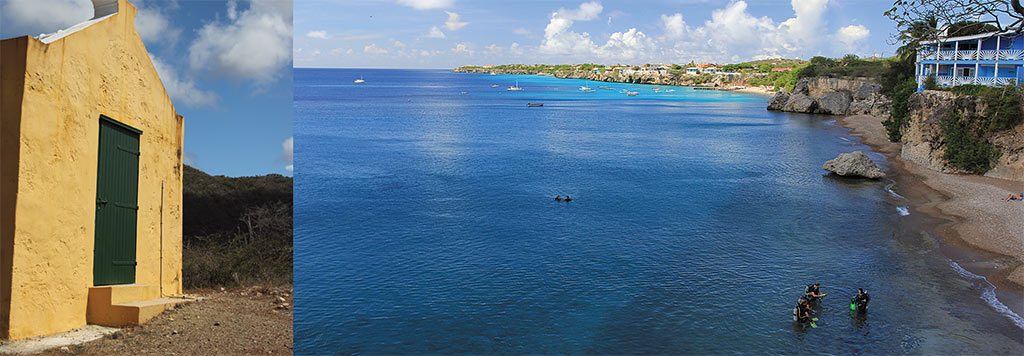
A visit to the Westpunt area offers a glimpse of local flora and fauna, well-preserved historical sites — and breathtaking ocean views
Curaçao’s signature dive sites include the wreck of the Superior Producer, a cargo ship sunk in 1977 that rests in about 100 feet (30 m) of water. It is blanketed in coral growth and seemingly guarded by a gang of great barracudas. Another favorite is the famous Mushroom Forest, which is a striking series of unusual, mushroom-shaped star coral formations. This site is off Westpunt, which is about 30 minutes from the airport, and an hour’s drive from Willemstad. Another Westpunt favorite is the Sponge Forest, which is a sloping wall festooned with all kinds of colorful sponges — orange elephant ear sponges, purple stovepipe sponges, gigantic barrel sponges, and more. Go West Diving is located at Westpunt and offers shore and boat diving. The dives off Barracuda Point and East Point are favorites as well. And a trip to Klein Curaçao is a highlight to any dive vacation.
Local dive centers offer practically every type of diving service you’d like, including all levels of instruction, from introductory “discover scuba” courses to technical and professional training, nitrox fills, night diving, underwater camera rental and photo courses. In our experience, the level of service offered by local dive operators is among the best we’ve ever seen. We found them to be safety-conscious, conservation minded, and genuinely fun to dive with.
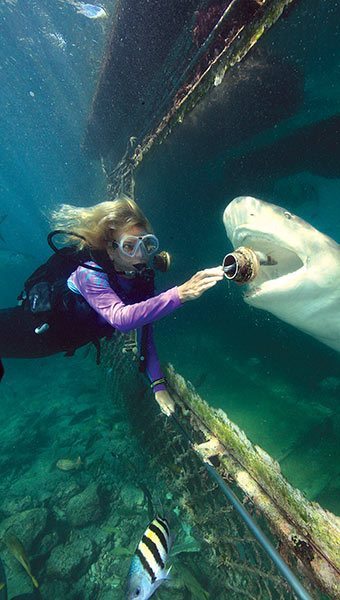
Handfeeding sharks is a thrilling experience at Animal Encounters Curaçao.
Diving, But Different
Animal Encounters Curaçao allows divers and nondivers alike the opportunity to view and interact with marine creatures in a truly unique way. They offer a series of enclosed marine habitats adjacent to the ocean, through which seawater freely flows. Certified and noncertified divers and snorkelers can enter areas adjacent to Sea Aquarium Curaçao in which they can swim with tarpon, grouper and yellowtail snapper and feed southern stingrays. There’s even the unique and exciting opportunity to feed sharks (safely, from behind a thick Plexiglas partition). Those who’d prefer to remain dry and at a distance from the sharks can still witness the excitement from the “viewing boat.”
Ocean Encounters Diving and Dolphin Academy also provide a special “open water dolphin dive” during which certified divers can swim with trained dolphins at a site called Shipwreck Point. A similar program is available for noncertified divers, which takes place in a shallow lagoon.
If that’s not enough diving diversity, voyages to the deep via submarine are available through Sea Aquarium Curaçao. Reservations are required for all these programs.
The Land and Landhuizen
At first glimpse Curaçao’s landscape may seem rather barren, but look closely and you’ll be pleasantly surprised. Visits to Shete Boka National Park and Christoffel National Park, both located in Westpunt, are well worth it, both for the topside touring and for breathtaking ocean views from several cliffside viewpoints.
There are more than 450 species of local flora, including hundreds of different cacti. One plant you have to avoid contact with is the manzaliña tree, called manchineel in other parts of the Caribbean. Found near coastal beaches, this tree has rough, dark bark and small green leaves. The fruit is poisonous, and the sap will burn the skin if touched.
Whiptail lizards, endemic to Curaçao, can be found basking in the sun. Geckos inhabit the scrubby trees, keeping the mosquito population in check. One species of gecko, a translucent tan color, with bulging black eyes and splayed limbs, has sucker feet, which allows it to scale walls. Locals call this species the “plakiplak,” meaning “stickystick.”
The iguana is the king of Curaçao reptiles and its meat and eggs are coveted as supposedly powerful aphrodisiacs. In fact, iguana soup is a local delicacy.
Two species of snakes can be found on Curaçao, and both are completely harmless.
The island hosts a total of 11 native breeds of mammals, which include the Curaçao white-tailed deer and eight species of bats. It is not uncommon to see goats or donkeys wandering the streets, particularly in the more rural areas.
More than 168 bird species have been registered on Curaçao. At least 51 of these species are breeding birds, 71 are migrants from North America, 19 are visitors from South America and 19 are seabirds.
Curaçao’s Landhuizen, or “country houses” were built in the 18th and 19th centuries and are former plantation houses. There used to be 100 such small plantations on Curaçao. The central pivot of each plantation was the landhuis, where the master lived. Situated around the country house were the storehouses and the huts of the slaves who worked the land. About 55 of these landhouses still remain, several of which are open for public viewing.
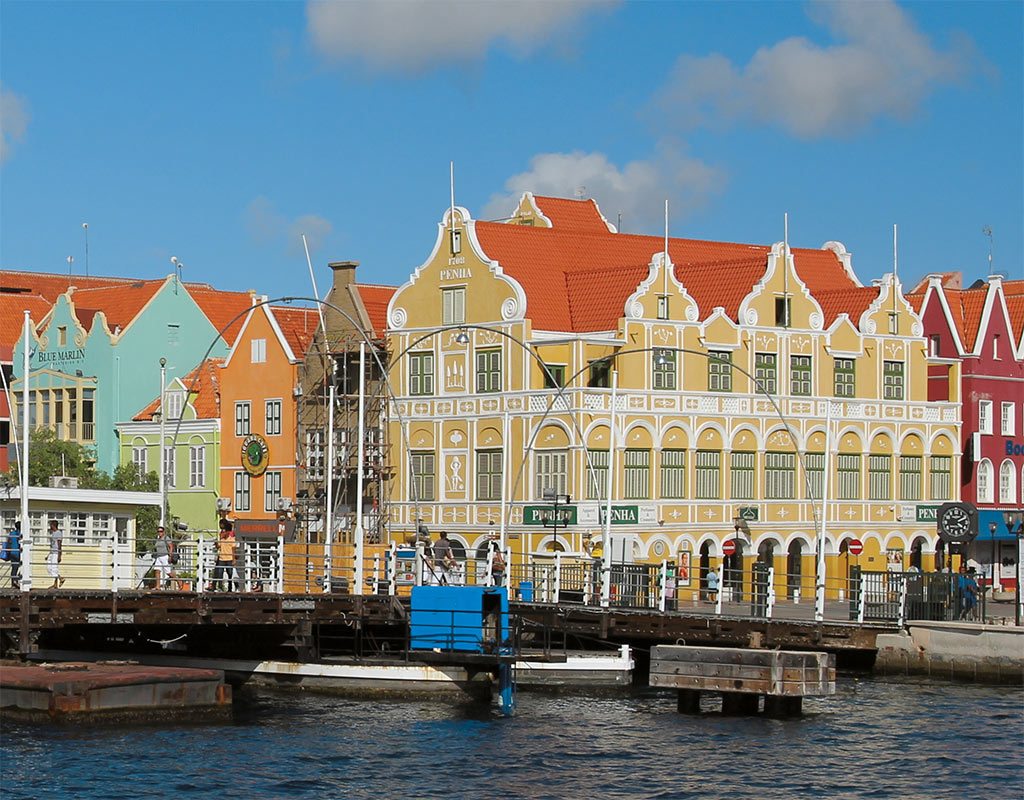
Colorful Willemstad waterfront
Willemstad
Every great destination has its marquee attraction. Willemstad is Curaçao’s.
The United Nations Educational, Scientific and Cultural Organization (UNESCO) is committed to preserving the culture and heritage of major sites around the world. The latest World Heritage list includes varied places like the Pyramids of Egypt, the Great Barrier Reef of Australia, East Africa’s Serengeti — and Curaçao’s Willemstad.
In 1997, the UNESCO World Heritage Site committee selected the historic city center — one of just six Caribbean sites chosen — because of its “outstanding value and integrity, which illustrates the organic growth of a multicultural community over three centuries, and preserves to a high degree significant elements.”
The city itself is actually divided in two sections, Punda and Otrobanda, connected by the famous Queen Emma bridge, which was built in 1888 and is supported by 16 floating pontoons. Also known as the “Swinging Old Lady,” it swings open using two powerful ship motors, allowing ships to access the port.
More than 750 of Willemstad’s buildings are national monuments, but the city is best enjoyed outdoors. The streets are pedestrian-friendly, offering easy exploration and great shopping. When it’s time to relax, stop by one of the many outdoor cafés to enjoy a meal or take in the nightlife after sunset. You’ll find the cuisine as colorful as the city, with many delicious dining options.
For divers, it’s primarily Curaçao’s blue hues and the undersea adventures that beckon, but it’s nice to have so many colorful and historically rich topside options to enjoy when the diving’s done. This, and the genuine warmth and friendliness of the locals, make Curaçao a Caribbean destination worth visiting time and time again.
Story and Photos by Cathryn Castle and Guilherme Garcia
The authors wish to thank the following for their assistance with this article: Lions Dive Resort and Ocean Encounters, Animal Encounters Curaçao, Sea Aquarium Curaçao, Santa Barbara Beach & Golf Resort, and the Curaçao Tourist Bureau.

